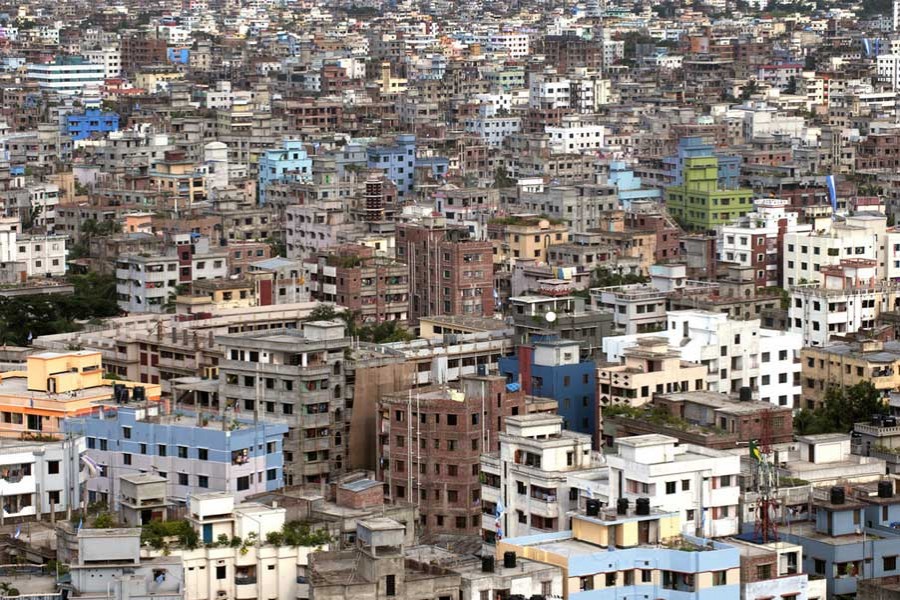
Published :
Updated :

Dhaka, the city we live in, have grown with, and still build our hopes on, is the nerve-centre of an unstoppably advancing economy. It is the emotional resort to which we return slouching through a hideous traffic after a hard day's work or from a business trip overseas-into the warmth of its arms.
But the city we hold in a love-hate embrace has lately been the recipient of pungent criticism, obscuring even its tradition of hospitality! It has drawn flak, almost with routine regularity for its declining ranking on livability indices on year-to-year basis-in terms of stress, environmental pollution, hazards of movement (pedestrian accidents accounting for 72 per cent) and women's safety. That we are a few notches higher or lower than the previous year's ranking doesn't really matter; because as it happens, the fundamentals of the city have gone haywire since as far back as we can remember.
We have been hearing for a long time an old theme song that we need to have growth epicentres all over the country to let Dhaka ease off some of its extremely strenuous burden.
Nothing came off the hyped signature tune as suppressed or token, wishy-washy approach to reducing burden on the megalopolis popped out like hernia elsewhere on the wretched infrastructure.
The argument for taking that course is more pronounced today than ever before; for Dhaka has already become unsustainable with its size of population, the dire projection of where it can get in 2020, especially with migrating numbers from the outlying areas in prospect. Then you have a mere six-seven per cent road network of the total city landmass, severe sewer and drainage tangle causing pervasive water-logging, the spectre of land subsidence, let alone poor air quality, crippling man hour losses, whittling down of gross domestic product (GDP) add-ons - the list of damages sustained can go on and on!
Now experts at an international conference entitled 'Cities Forum: Building Knowledge Networks and Partnerships for Sustainable Urban Development in Bangladesh' held last Saturday showed a path out of the morass.
They appear to have laid emphasis on a known theme viz. development of small urban centres to reduce the strain on the capital city. But there is more meat to the suggestion. For maximising the positive effect of dispersed urban centres these must go hand- in-hand with growth of livelihood options. Basically industrialisation and expansion of service sectors have beefed up a bigger contribution to the GDP growth as compared with that of agriculture.
The critical factor in the add-on strategy consists in setting up strings of skill development institutes to cater to the demand for skilled human resource towards job creation to hold the rural educated to their habitats-gainfully across the board. This would be a big disincentive for migration to the cities, apart from meeting demands for skilled manpower in overseas markets. The specialised economic zones being on the anvil, these would need to be dove-tailed to the overall strategy for a massive breakthrough in the attainment of sustainable development goals (SDGs).
There is an advantage to be derived from some apparent disadvantages. For instance, the rate of urbanisation in Bangladesh is way lower than that of our regional counterparts. According to UN figures, the rate of urbanisation in Bangladesh was 33.5 per cent in 2014. The global average is about 54 per cent to Asia's 48 per cent. We are ahead of India, Nepal and Bhutan (32 and 18 percent respectively).
Thus, there is a leeway for us to jump start a new urban development on a sustainable basis helped by latest technology.
We endorse the insightful suggestion of Professor Mahmud, the general secretary of the Bangladesh Institute of Planners, for targeted urbanisation.
We will have to focus on urban centres with relatively balanced population.
There are 28 urban centres with 0.1 million to 1.0 million population and 63 centres with 50,000 to 0.1 million population. These provide avenues for dispersal of population away from cities like Dhaka, Chittagong and Khulna.
safarihi43@gmail.com


 For all latest news, follow The Financial Express Google News channel.
For all latest news, follow The Financial Express Google News channel.